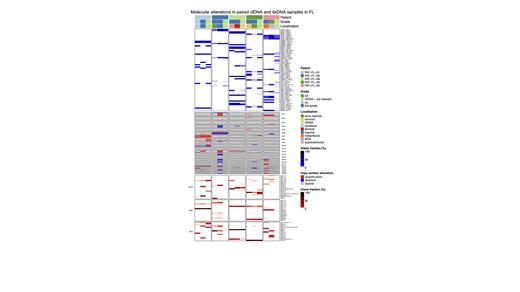Background: Scrutiny of genetic heterogeneity in follicular lymphoma (FL) patients has been mainly limited to the investigation of single-site biopsies in previous studies, while the potential of circulating cell-free DNA (cfDNA) to resolve intra-patient heterogeneity has not been fully exploited in FL. Therefore, we aimed to characterize spatiotemporal heterogeneity in relapsed/refractory (R/R) FL by performing comprehensive genomic profiling of spatially separated tissue samples with matching cfDNA samples collected throughout the disease course.
Methods: We performed ultra-deep targeted sequencing of 63 tumor tissue DNA (tisDNA), 28 cfDNA and paired germline DNA samples collected from 22 R/R FL patients. Sequencing libraries were prepared using a SureSelectXT HS (Agilent, USA) panel encompassing 173 genes recurrently mutated in FL, as well as rearrangement regions for immunoglobulin V(D)J repertoire profiling. Sequencing was performed on a NovaSeq6000 or NextSeq2000 (Illumina, USA) platform reaching a median deduplicated depth of 5,419x and 1,695x for cfDNA and tisDNA samples, respectively. We called short somatic variants using GATK Mutect2 (v.4.1.7.0), copy number alterations using PureCN (v.1.20.0) and CNVKit (v.0.9.9), as well as immunoglobulin repertoire using the whole-mark module of ARResT/Interrogate.
Results: Median 6 and 8 non-silent variants were detected in cfDNA and tisDNA samples, respectively, affecting KMT2D (52%), CREBBP (45%) and TNFRSF14 (33%) most frequently in both sample types. Non-silent variants were detected in 21 of 24 (87.5%) pretreatment cfDNA samples. Comparing tisDNA samples with matching pretreatment cfDNA samples median 63.6% of variants were shared, yet unique variants were identified in cfDNA in 13/20 sample pairs, involving a median 14.3% of the variants. Studying the phylogenetic evolution of tumor samples pointed to early branching in majority of the patients, with ubiquitously present mutations detected in all samples constituting a median 24.3% of variants, although late branching was also observed in a subset (2/22) of the patients with at least 50% of variants detected in all samples. Most conserved variants were detectable in KMT2D and CREBBP, with notable exceptions of a lower mutation prevalence, but a high conservation rate in ATP6V1B2 and STAT6 genes. Subclonal clustering of variants and hierarchy analysis of samples from patients (n=5) with 2 tisDNA collected at separate lymphoma sites and a matching pretreatment cfDNA indicated that spatially discordant variants formed the same subclone, that could be also recovered in cfDNA in 4/5 patients (80%). An additional patient presented with almost identical tisDNA samples, but further unique mutations in cfDNA (PAT-FL-20)(Figure 1.). Investigating the prognostic significance of ctDNA level in the relapsed setting revealed that higher ctDNA levels were significantly associated with poor response to therapy (p=0.023, Kruskal-Wallis test), yet when we stratified patients by the median pretreatment ctDNA level (1.44x10 5 haploid genome equivalent/mL plasma) progression free survival in the subsequent treatment line was not substantially different between the two arms (p=0.11, log-rank test).
Conclusion: Based on our results, R/R FL is characterized by remarkable intra-patient genetic heterogeneity. Although the founder clone harboring pathogenic KMT2D and CREBBP mutations can be identified in majority of the samples, expansion of tumor subclones between lymphoma sites confers divergent evolution, leaving genetic alterations unidentified during single-site based genetic testing. We also provide preliminary evidence, that multitarget high-throughput sequencing of cfDNA can uncover spatially restricted subclones that play a role in disease progression in R/R FL and that pretreatment ctDNA level might have a predictive value in the relapsed setting of FL.
Figure 1. Molecular alterations in FL patients with tisDNA samples from two separate lymphoma sites and a matching cfDNA. KMT2D and CREBBP variants show high conservation, yet further variants are often spatially restricted, which can be resolved by cfDNA profiling. Copy number alterations (CNA) show lower concordance, yet recurrent CNA-s can be recovered in a subset of the cases. Identical immunoglobulin heavy and light chain usage can be detected in all samples of 3 patients and in paired tisDNA in 2 patients.
Disclosures
No relevant conflicts of interest to declare.


This feature is available to Subscribers Only
Sign In or Create an Account Close Modal